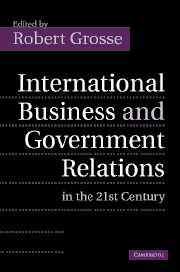Book contents
- Frontmatter
- Contents
- List of figures
- List of tables
- List of contributors
- Acknowledgments
- Introduction
- Part I History and theories of analysis of international business–government relations
- 1 Early US business-school literature (1960–1975) on international business–government relations: its twenty-first-century relevance
- 2 Institutional reform, foreign direct investment, and European transition economies
- 3 Corporate governance in the global economy: international convergence or continuing diversity?
- 4 Revisiting rival states: beyond the triangle?
- Part II The shifting international business–government partnership
- Part III Bargaining theory and the obsolescing bargain
- Part IV Host and home government views of international business
- Conclusions
- References
- Select bibliography of J. N. Behrman's works
- Index
1 - Early US business-school literature (1960–1975) on international business–government relations: its twenty-first-century relevance
Published online by Cambridge University Press: 22 September 2009
- Frontmatter
- Contents
- List of figures
- List of tables
- List of contributors
- Acknowledgments
- Introduction
- Part I History and theories of analysis of international business–government relations
- 1 Early US business-school literature (1960–1975) on international business–government relations: its twenty-first-century relevance
- 2 Institutional reform, foreign direct investment, and European transition economies
- 3 Corporate governance in the global economy: international convergence or continuing diversity?
- 4 Revisiting rival states: beyond the triangle?
- Part II The shifting international business–government partnership
- Part III Bargaining theory and the obsolescing bargain
- Part IV Host and home government views of international business
- Conclusions
- References
- Select bibliography of J. N. Behrman's works
- Index
Summary
Robert Merton once remarked that “[the sociologist] has ample reasons to study the works of Weber, Durkheim and Simmel and, for that matter, to turn back occasionally to the works of a Hobbes, Rousseau, Condorcet or Saint Simon … Previously unretrieved information is still there to be usefully employed as new points of departure” (1967, pp. 34 and 37).
His exhortation certainly applies to international business–government relations (IBGR), but who still reads Jack Behrman, Richard D. Robinson, and John Fayerweather who wrote expertly and at length on this topic? For that matter, who has even heard of them among the younger generation of IBGR scholars? The late Raymond Vernon and Charles Kindleberger (partly on account of Hymer's thesis) have fared better in this regard, but why has this happened?
One could speculate that the relevant and cumulative knowledge of the past (here defined as 1960 to 1975) has been substantially incorporated in subsequent formulations, so that the above authors need no longer be read and cited since many textbooks on international business, marketing, finance, management, and strategy now include sections and even chapters on the structures and roles of governments as well as on negotiating with them.
Besides, the search for relevance in teaching and research has dictated a focus on current phenomena, institutions, and developments – such as globalization, the North American Free Trade Association (NAFTA), and the World Trade Organization (WTO) – which far surpass in size and scope those analyzed by scholars of the 1960s and 1970s.
- Type
- Chapter
- Information
- Publisher: Cambridge University PressPrint publication year: 2005
- 5
- Cited by



